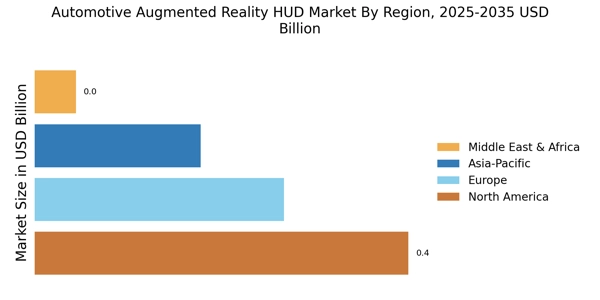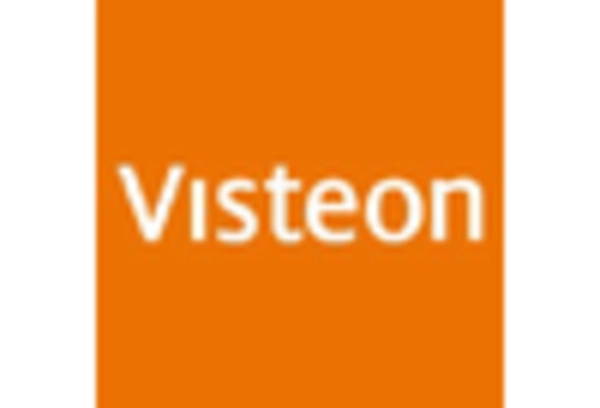Rise of Electric and Autonomous Vehicles
The Automotive Augmented Reality Hud Market is significantly influenced by the rise of electric and autonomous vehicles. As these vehicles become more prevalent, the need for innovative interfaces that communicate essential information to drivers and passengers is paramount. Augmented reality HUDs offer a unique solution by providing real-time data on battery status, navigation, and vehicle performance directly in the driver's field of vision. Market analysts project that the electric vehicle segment will account for a substantial share of the automotive market, with sales expected to exceed 30 million units by 2030. This shift towards electrification and automation is likely to create new opportunities for the Automotive Augmented Reality Hud Market, as manufacturers seek to differentiate their offerings through advanced technology. The integration of AR HUDs in these vehicles could enhance user experience and facilitate the transition to autonomous driving.
Integration of Advanced Display Technologies
The Automotive Augmented Reality Hud Market is experiencing a notable surge due to the integration of advanced display technologies. Innovations in optics and display systems, such as OLED and microLED, enhance the visual clarity and brightness of HUDs, making them more appealing to consumers. As automotive manufacturers increasingly adopt these technologies, the market is projected to grow significantly. According to recent estimates, the market for augmented reality displays in vehicles is expected to reach USD 3 billion by 2026. This growth is driven by the demand for high-quality visual interfaces that provide real-time information to drivers, thereby improving the overall driving experience. Furthermore, the seamless integration of these displays with vehicle systems is likely to enhance user engagement and satisfaction, positioning the Automotive Augmented Reality Hud Market for continued expansion.
Regulatory Support for Advanced Safety Technologies
The Automotive Augmented Reality Hud Market is poised for growth due to increasing regulatory support for advanced safety technologies. Governments worldwide are implementing stricter safety standards that encourage the adoption of innovative solutions like augmented reality HUDs. These regulations aim to reduce road accidents and enhance overall vehicle safety. For instance, initiatives promoting the use of HUDs for displaying critical driving information are gaining traction, as they are proven to minimize distractions. Market forecasts indicate that the regulatory landscape will continue to evolve, further supporting the integration of AR technologies in vehicles. This regulatory push is likely to create a favorable environment for the Automotive Augmented Reality Hud Market, as manufacturers align their products with safety standards and consumer expectations. The emphasis on safety is expected to drive demand for AR HUDs, making them a vital component of future vehicle designs.
Growing Demand for Enhanced Driver Assistance Systems
The Automotive Augmented Reality Hud Market is being propelled by the growing demand for enhanced driver assistance systems. As safety regulations become more stringent, automotive manufacturers are increasingly incorporating augmented reality HUDs to provide critical information directly in the driver's line of sight. This technology aids in reducing distractions and improving situational awareness, which is essential for safe driving. Market data indicates that the adoption of advanced driver assistance systems (ADAS) is expected to grow at a compound annual growth rate of over 20% in the coming years. This trend suggests that the integration of augmented reality HUDs will play a pivotal role in the evolution of ADAS, thereby driving the Automotive Augmented Reality Hud Market forward. The ability to overlay navigation, speed, and hazard alerts directly onto the windshield enhances the driving experience and aligns with consumer preferences for safety and convenience.
Consumer Preference for Connected Vehicle Technologies
The Automotive Augmented Reality Hud Market is also benefiting from the increasing consumer preference for connected vehicle technologies. As vehicles become more integrated with mobile devices and cloud services, the demand for HUDs that can display real-time data from smartphones and other connected devices is on the rise. This trend is indicative of a broader shift towards smart mobility solutions, where drivers expect seamless connectivity and access to information. Recent surveys suggest that over 70% of consumers are interested in vehicles equipped with advanced connectivity features, which bodes well for the Automotive Augmented Reality Hud Market. The ability to project navigation, music, and communication alerts directly onto the windshield enhances convenience and safety, making AR HUDs an attractive option for modern consumers. This growing preference is likely to drive innovation and investment in the market.



















Leave a Comment